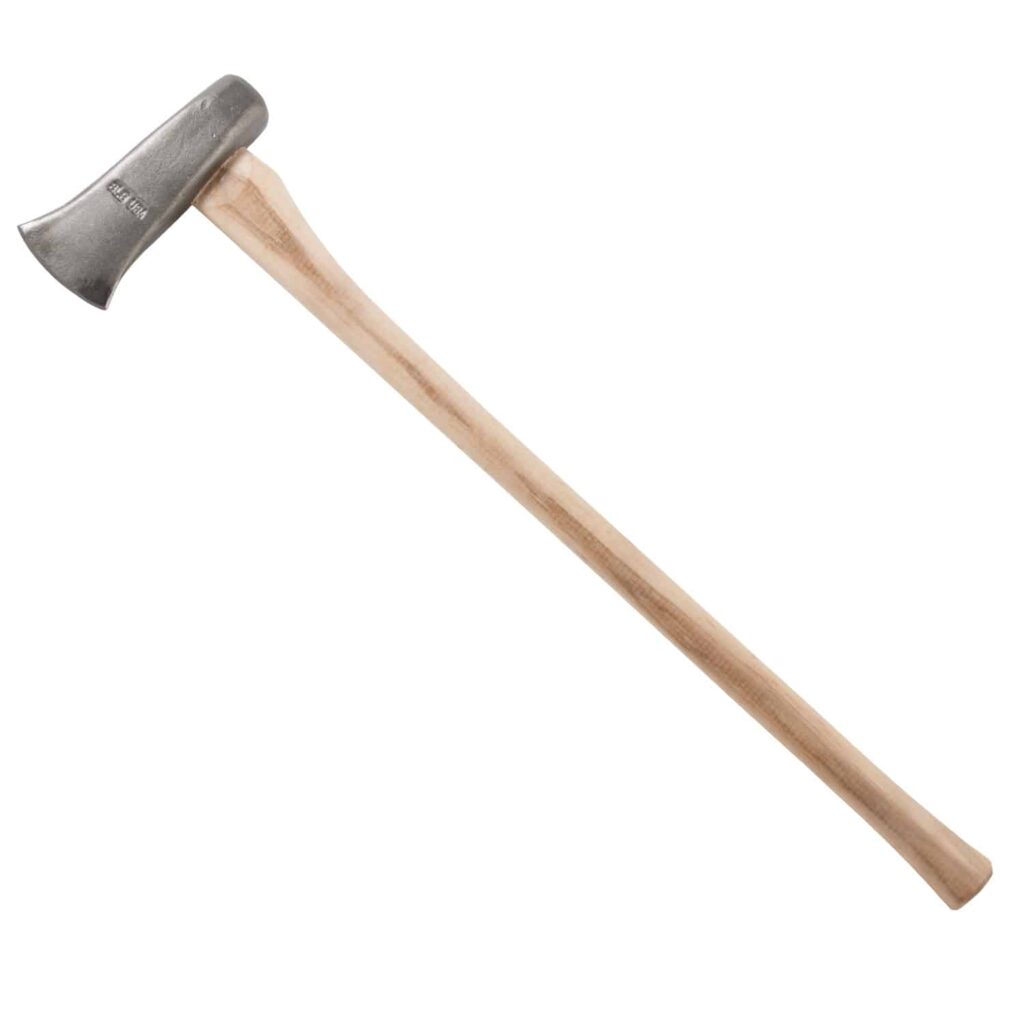A maul is a heavy, long-handled hand tool used for splitting wood, featuring a large, wedge-shaped metal head with a blunt, sledgehammer-like side opposite the splitting edge. Its weight and design are ideal for splitting large logs and driving splitting wedges, providing more force than a traditional axe.
A maul is a tool used for anything from fighting battles in medieval times to splitting firewood in the modern age. They are one of the most commonly used tools to cut wood that works by forcing the wood fibers apart using their blunt blade. Here’s what you should know about mauls.
Table of Contents
What is a Maul Used For?
Maul refers to different large hammers, such as war hammers, spike maul, post maul, and splitting maul. While these hammers may look similar, they have some unique features that differentiate them. For instance, a war hammer is a medieval weapon, and a splitting maul is a big wood-splitting tool more similar to an axe than a hammer.
The maul’s origin dates back to the 14th century when warriors used it for combat. At the time, a maul was a heavy weapon, and a single blow could prove fatal. Over time, the maul upgraded according to its users’ needs and requirements. Later, manufacturers designed mauls equipped with a blunt axehead for lumberjacks, loggers, and landowners to split firewood easily. These mauls were perfect for splitting wood in a single swing of their heavy head.
Since the primary purpose of mauls is to split the wood into pieces, these tools have a composition of high-quality and durable materials like wood and steel. The handle is normally made of wood, such as American hickory, or modern fiberglass composites.
The main purpose of a modern maul is to split firewood.

Key Design Features
A standard maul has a large, blunt axehead with a flat poll on the other side. The axehead is used to split firewood, while the other side can be used as a hammer for putting stakes in the ground. Mauls generally have long handles of around 28 to 32 inches to generate as much power as possible. Selecting a maul’s length and weight based on your own strength and frame is crucial.
You can tell the difference between a splitting axe and a splitting maul because of the blade’s sharpness and shape.
Just like with other tools, mauls have gone through serious upgrades. Most of them have the following features:
- Thick profile bit
- Blunt blade
- Variety of weights and handle lengths
- Straight handle
- Shock resistant handle made from different materials, like fiberglass or wood.
Nowadays, a maul is the most common tool for people looking to cut wood for the fireplace.

Modern Brands
I have seen mauls in local stores; each has standard features and designs. However, they often lack quality and can be damaged after several uses. People looking to invest in quality products should go for reputable brands. These brands offer quality and deliver unique features that differentiate them from alternatives.
You can find mauls with non-slip handles to keep them from falling from your hands if you lose your balance or if it’s wet. Modern brands also offer lightweight mauls, which are much more maneuverable and suited for smaller frames.
I understand how challenging it can be to lift heavy wooden mauls, let alone swing them. This is why many brands are not using wood to create handles. Instead, they’re using lightweight materials, like plastic and fiberglass.
In addition, you can find mauls with different colors and designs depending on your that give you a different look (although I prefer the wooden aesthetics).
Looking for reliable brands in the market? Here are a few options you have.
- Estwing
- Performance Tool
- Halder
- Fiskars
- Wilton
- Husqvarna
- Council Tool
I have written a guide reviewing the best splitting mauls manufactured today if you want more details on these individual products.
- 8 Pound Total Weight
- 36 inch Shock Absorbing Composite Handle
- Optimized Bit Profile to Split Wood Fibers Apart
- Rust-Resistant Heat Treated Steel Axehead
Husqvarna Wooden Splitting Maul
- 32-inch Hickory Wooden Handle
- Hardened Poll for Hammering in Splitting Wedges
- Protected Neck to Avoid Damage
- Includes a Leather Edge Cover
1844 Helko Werk Splitting Maul
- Hand Forged in Germany
- C50 High Carbon Steel with 53-56 HRC Hardness
- 36-inch Grade A American Hickory Handle with Linseed Oil Finish
- Powerful 9 Pound Total Weight
Are mauls and axes the same?
An axe and maul are different. Though they both help split and cut wood, mauls are generally much heavier due to their bulky head and can generate more power into the log.
Mauls also have blunt heads that don’t cut the wood as much as break it apart.
Axes are more versatile and can perform various tasks, while maul is more specialized.
How heavy are mauls?
Splitting mauls are generally some of the heaviest axes on the market and weigh between 5 and 8 pounds. The length of the handle and its material significantly impact on the total weight of the tool.
Conclusion
A maul is a tool similar to an axe but has a blunter axehead shape. The handle can feature materials like wood, fiberglass or even plastic. They are generally larger and heavier than axes, and their primary purpose is to split dense logs for firewood.
Manufacturers have made numerous upgrades to the historic design, creating new types of mauls. It’s important to approach the right brand for a high-quality maul.



